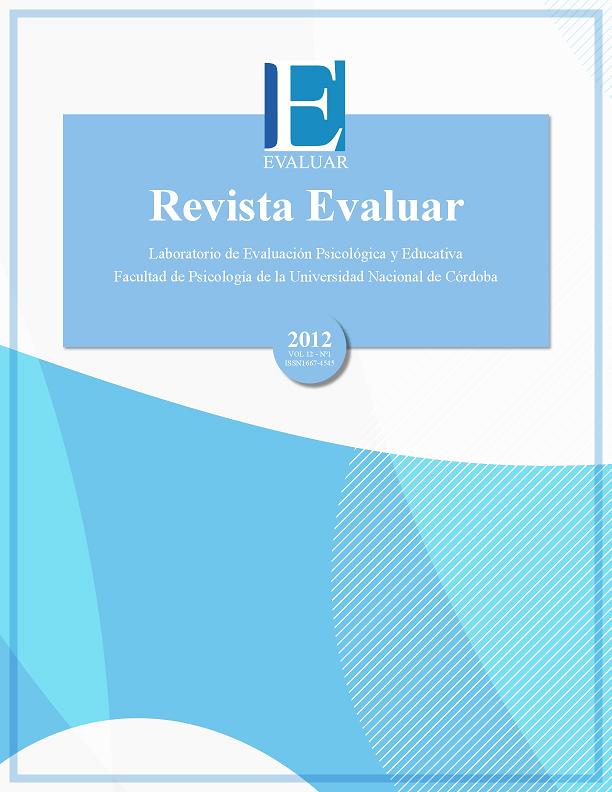Assessment of emotionalindicators of The Human Figure Drawing in children at psychological ambulatory consultation
DOI:
https://doi.org/10.35670/1667-4545.v12.n1.4696Keywords:
DFH, indicadores emocionales, problemas emocionales, trastornos de ansiedad, trastornos del estado del ánimo, problemas paterno filialesAbstract
This paper aims to examine the possible usefulness of the Test of Human Figure Drawing in Primary Health Care. Specifically, it will refer to the Emotional Indicators (EIs) (Koppitz, 1984) by analyzing its use as a tool for identifying children with emotional problems, and to discriminate among them, those with Mood Disorders, Anxiety Disorders and Parent-child problems.We propose to compare the presence of these IEs in a sample of 44 children aged between 6 to 12 years, residents of Metropolitan Area of Buenos Aires, who receive psychological assistance, with a control group of children from the general population, balanced according to sociodemographicvariables.Data analysis shows that the number of EIs proposed (Koppitz, 1984) does not dicriminate productions of children with emotional problems. Also, in the consulting population does not discriminate between types of disorders.
Downloads
References
Abreu, M., & Vanja, B. (2006). Emotional indicator of sexual abuse in projective drawings of human figure. Revista de Terapia Sexual de Pareja, 25, 51-73.
AFAPSAM (2004). Clasificación Francesa de los Trastornos Mentales del niño y del adolescente. Buenos Aires: Polemos.
Aldridge, J., Lamb, M. E., Stemberg, K., Orbach, Y., Esplin, P. W., & Bowler, L. (2004). Using a human figure drawing to elicit information from alleged victims of child sexual abuse. Journal of Consulting and Clinical Psychology, 72, 304-316.
American Psychiatric Association (2002). Manual diagnóstico y estadístico de los trastornos mentales. DSM-IV TR. Barcelona: Masson.
Barros, M. C., & Ison, M. (2002). Conductas Problemas Infantiles: Indicadores Evolutivos y Emocionales en el Dibujo de la Figura Humana. Revista Interamericana de Psicología, 36 (1), 279-298.
Brizzio, A., López, L., Freiberg, A., Grillo, A. Luchetti, Y., & D ́Amelio, V. (2010). Estudio preliminar acerca de los indicadores emocionales del test del dibujo de la figura humana. Memorias II Congreso Internacional de Investigación y Práctica Profesional en Psicología de la Facultad de Psicología de la UBA, 4, 497-498.
Brizzio, A., López, L., Luchetti, Y., & Grillo, A. (2011). Estudio acerca de los indicadores emocionales del test del dibujo de la figura humana en niños con problemas emocionales. Memorias III Congreso Internacional de Investigación y Práctica Profesional en Psicología de la Facultad de Psicología de la UBA, 4, 111-113.
Carrol, M., & Ryan-Wenger, N. (1999). School-age children ́s fears, anxiety, and human figure drawings. Journal of Pediatric Health Care, 13, 24-31.
Casullo, M. M. (1991). El test del dibujo de la figura humana. Normas regionales. Buenos Aires: Guadalupe.
Cayssials, A. (2004). Algunas reflexiones sobre la evaluación psicológica infanto juvenil. Revista Venezolana de Psicología Clínica Comunitaria, 4, 19-27.
Cayssials, A. (2010). ¿Cuali y/o Cuanti? Aportes para elaborar informes integrativos en Psicologia. Buenos Aires: Paidós.
Cooke, E. (1985). On art teaching and child nature. Journal of Education, 8, 12-15.
Di Leo, J. (1978). Los dibujos de los niños como ayuda diagnóstica. Buenos Aires: Paidós.
Driessnack, M. (2005). Children’s drawings as facilitators of communication: A Meta-analysis. Journal of Pediatric Nursing, 20, 415-423.
Elif Daglioglu, H., & Umit Deniz, A. (2010). A study on the emotional indicators in 5-6 year-old girls and boyshuman figure drawings. Procedia Social and Behavioral Sciences, 2, 1503-1510.
Fernández Liporace, M. M. (1997). El dibujo de la figura humana. Buenos Aires: Psicoteca.
Goodenough, F. (1926). Test de inteligencia infantil por medio del dibujo de la figura humana. Buenos Aires: Paidós.
Goodenough, F. (1928). Studies in the psychology of children’s drawings. Psychological Bulletin, 25, 272-283.
Gross, J., & Hayne, H. (1998). Drawing facilitates children’s verbal reports of emotionally laden events. Journal of Experimental Psychology, 4, 163-179.
Hammer, E. (1958). The Clinical application of proyectives drawings. Springfield: Charles C. Thomas Publisher.
Hamrin, V., & Pachler, M. (2005). Child and adolescent depression: Review ofthe latest evidence based treatments. Journal of Psychosocial Nursing, 43, 54-63.
Harris, D. B. (1963). Children's drawings as measures of intellectual maturity. New York: Harcourt, Brace & World, Inc.
Hibbard, R. A., & Hartman, N. G. (1990). Emotional indicators in human figure drawings of sexually victimized and nonabused children. Journal of Clinical Psychology, 46, 211-219.
Kern de Castro, E., & Moreno-Jiménez, B. (2010). Indicadores emocionais no desenho da figura humana de crianzas transplantadas de orgaos. Psicología: Reflexao e Crítica, 23, 64-72.
Khon, S. W. (2002). The utility of projective instruments in identifying depression in aggressive children. Dissertation Abstract International: Section B: The Sciences and Engineering, 63(5-b), 2639.
Koppitz, E. (1966). Emotional indicators on human figure drawings of children: A validation study. Journal of Clinical Psychology, 22(3), 313-315.
Koppitz, E. (1968). Psychological evaluation of children's human figure drawings. New York: Grune & Stratton.
Koppitz, E. (1976). El Dibujo de la figura humana en los niños.Buenos Aires: Guadalupe.
Koppitz, E. (1984). Psychological evaluation of human figure drawings by middle school pupils. Orlando, FL: Grune & Stratton.
Kortesluoma, R. L., Punamäki, R. L., & Nikkonen, M. (2008). Hospitalized children drawing their pain: the contents and cognitive and emotional characteristics of pain drawings. Journal of Child Health Care for Professionals Working with Childrenin the Hospitaland Community, 12, 284-300.
Laak, J., de Goede, M., Aleva, A., & Van-Rijswijk, P. (2005). The Draw-A-Person Test: An indicator of children’s cognitive and socioemotional adaptation? The Journal of Genetic Psychology, 166, 77-93.
Lukash, F. N. (2002). Children's art as an index of anxiety. Plastic and Reconstructive Surgery, 109(6), 1777-1786.
Machover, K. (1949). Personality projection in the drawing of the human figure. Springfield: Charles C. Thomas Publisher.
Maganto Mateo, C., & Garaigordobil Landazabal, M. (2009). El diagnóstico infantil desde la expresión gráfica: el test de dos figuras humanas, Clínica y Salud, 20, 237-248.
Maganto, C., & Garaigordobil, M. (2011). Indicadores emocionales complementarios para la evaluación emocional del Test del dibujo de dos figuras humanas (T2F). Revista Iberoamericana de Diagnóstico y Evaluación Psicológica, 31, 73-95.
Malchiodi, C. (2009). The effectof posttraumatic stress disorder on children's humanfigure drawings. Dissertation Abstracts International: Section B: The Sciences and Engineering, 4490.
Mota, Z. G., Neri, G. S., López, C. B., & Lugo O. R. (2011). Impacto emocional de la información sobre sexualidad en pacientes adolescentes con mielomeningocele. Revista Mexicana de Medicina Física y Rehabilitación, 23, 63-66.
Murphy, K. (2004). Recognizing depression in children. The Nurse Practitioner, 29(9), 18-25.
Naglieri, J., McNeish, T., & Bardos, A. (1991). DAP: SPED. Draw a Person: Screening procedure for emotional disturbance: Examiner's Manual. Austin: Pro-Ed.
National Institute of Mental Health (2004). Depression in children and adolescents: A fact sheet for physicians. Recuperado el 15 de Julio de 2004 de www.nimh.nih.gov/publicat/depchildresfact.cfm
Organización Mundial de la Salud (1978). Conferencia Internacional sobre Atención Primaria de Salud, Declaración de Alma –Ata. Recuperado el 4 de Marzo de 2012 dehttp://www.paho.org/spanish/dd/pin/alma-ata_declaracion.htm
Organización Mundial de la Salud (2004).Disability-adjusted life year (DALY) rates, by WHO región. Recuperado el 10 de Diciembre de 2011 de http://www.who.int/gho/mortality_burden_disease/regions/dalys_text/en/index.html
Organización Mundial de la Salud (2006). ¿Cuáles son los primeros signos de los trastornos mentales? Recuperado el 20 de Marzo de 2012 dehttp://www.who.int/features/qa/38/es/index.html
Organización Mundial de la Salud (2008). Informe sobre la salud en el mundo 2008. La atención primaria de salud. Recuperado el 23 de Abril de 2012 dehttp://www.who.int/whr/2008/es/
Organización Mundial de la Salud (2012). Metrics: Disability-Adjusted Life Year (DALY). Quantifying the Burden of Disease from mortality and morbidity. Recuperado el 23 de Abril de 2012 de http://www.who.int/healthinfo/global_burden_disease/metrics_daly/en/
Özer, S. (2009). Relationship of Bender gestalt developmental scores and human drawing developmental scores in a sample of Turkish preschool children. School Psychological International, 30, 137-147.
Taborda de Velasco, R. (2002). Diagnóstico de la dinámica de la capacidad intelectual de niños de 4 a 6 años. Estudio clínico de los tests WPPSI, BG y DFH. Buenos Aires: Grupo Editor Lumen Humanitas.
Tielsch, A., & Jackson Allen P. (2005). Listen to then draw: Screening children in primary care through the use of human figure drawings. Pedriatric Nursing, 31, 320-327.
University of Utah Health Sciences Center (2003). Child and adolescent mental health. Recuperado el 13 de Enero de 2005 de www.med.utah.edu/healthinfo/pediatric/Mentalhealth/gad.htm
Unruh, A., McGrath, P., Cunningham, S. J., & Humphreys, P. (1983). Children’s Drawings of Their Pain. Pain,17, 385-92.
Wechsler, S. (1996). Odesenho da figura humana: avaliaçao do desenvolvimiento cognitivo infantil.Campinas: Edit. Psy.
Wechsler, S. (1999). O desenho da figura humana: avaliaçao do desenvolvimiento cognitivo infantil. Manual para crianças brasileiras. Campinas: Liyro Pleno.
Weinle, C. A. (2002). Facilitating children’s emotional expression through drawing: Focus on children of divorce. Unpublished dissertation, The University of Toledo, Toledo, OH.
Wesson, M., & Salmon, K. (2001). Drawing and showing: Helping children to report emotionally laden events. Applied Cognitive Psychology, 15, 301-319.
Zambrano Sánchez, E., Martínez Wbaldo, M., & Poblano, A. (2010). Frecuencia de factores de riesgo para problemas de aprendizaje en preescolares de bajo nivel socioeconómico en la ciudad de México. Revista Latino-Am. Enfermagem, 18, 1-7.
Downloads
Published
How to Cite
Issue
Section
License
Copyright (c) 2012 Analía Brizzio, Lucila López, Yanina Luchetti

This work is licensed under a Creative Commons Attribution 4.0 International License.
Revista Evaluar aplica la Licencia Internacional de Atribuciones Comunes Creativas (Creative Commons Attribution License, CCAL). Bajo esta licencia, los autores retienen la propiedad de copyright de los artículos pero permiten que, sin que medie permiso de autor o editor, cualquier persona descargue y distribuya los artículos publicados en Evaluar. La única condición es que siempre y en todos los casos se cite a los autores y a la fuente original de publicación (i.e. Evaluar). El envío de artículos a Evaluar y la lectura de los mismos es totalmente gratuito.




_(3).jpg)



.jpg)



